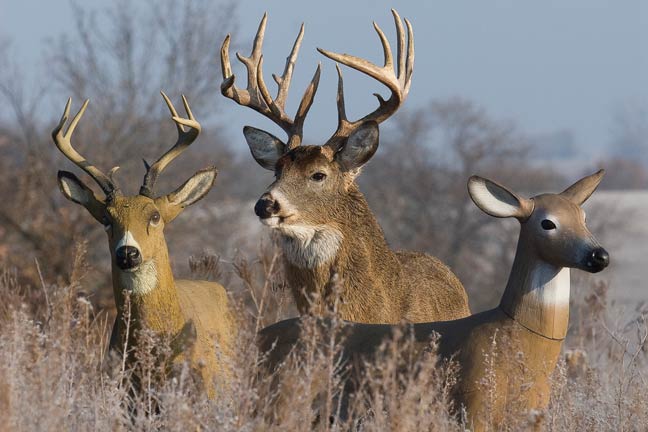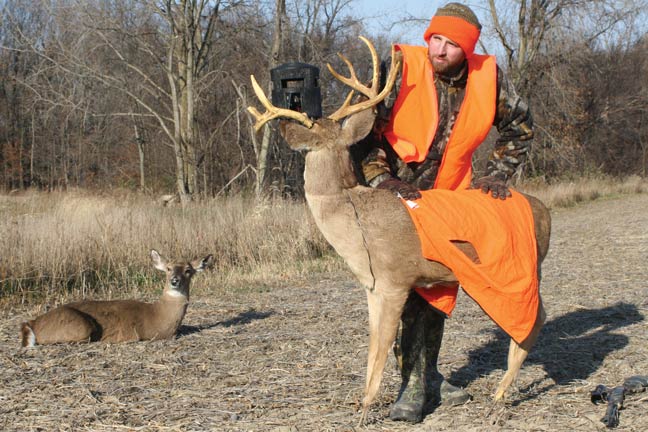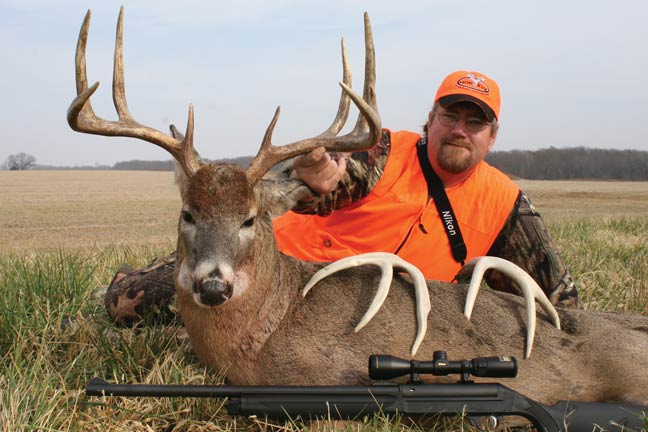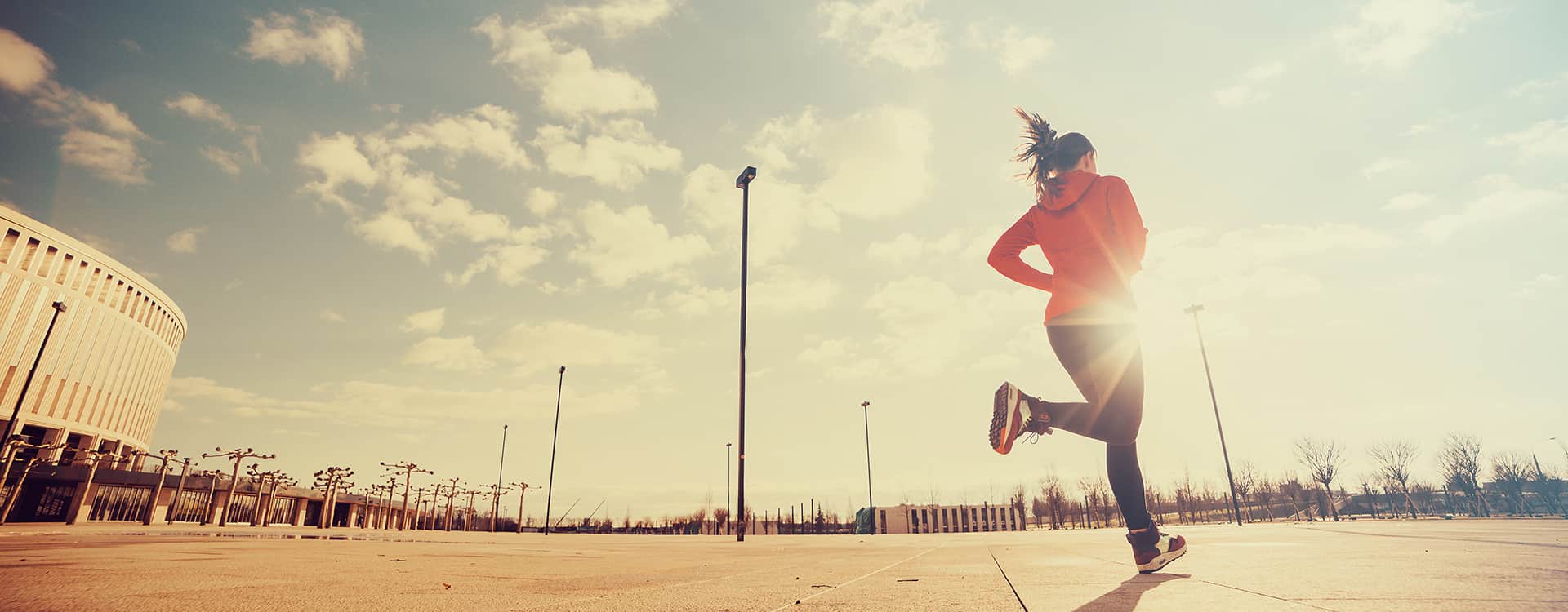The buck was an early arrival on this second afternoon of the Illinois gun season. Yes, I was hunting a tightly managed property, but there were shots ringing out from the surrounding tracts. So I hadn’t expected Mr. Big to step into the wide-open farm field for at least three more hours.
I was only there early because I had extra setup work to do and wanted to be done before the first doe arrived.

To a rutting buck, the sight of a rival tending a doe is hard to resist investigating. Photo by billkinney.com
Driving all the way back to the enclosed blind, I doused my rubber boots with Scent Killer and slipped them on. After dousing myself and the Custom Robotic Wildlife decoys with another round of spray, I positioned the bedded doe broadside at around 50 yards out. The 130-class buck decoy I stood as a sentry over her, guarding his prize.
Dousing a scent wick with Special Golden Estrus and another with Mega Tarsal Plus, I stuck twigs into the dirt behind each decoy, hung the appropriate wicks and got out of there. Now all I had to do was change clothes and spray down, and I’d finally be heading to the stand.
Now let’s fast-forward three hours. A sea of does, fawns and young bucks were now hammering the corner of the field and a somewhat hidden food plot that doglegged back into the cover.
With the decoys actually being full-body mounts, I won’t pretend the deer automatically accepted these stationary imposters as living deer — but the ultra-realistic images were way too convincing to send them running. Frankly, they were curiosities that, after a cautious inspection and a handful of head bobs by every doe in the area, were accepted as harmless at worst, real deer at best.
That’s about when the large body emerged, all the way on the opposite end of the open field. Despite his being too far away for me to spot antlers with the naked eye, I was convinced my binocular would reveal a good number of inches on the animal’s head.
I was right. I didn’t know how many points, but the rack was wide, tall and attached to a large body. I immediately wanted this buck, but he was somewhere north of 500 yards away and showing no signs of coming closer.
Grabbing the rattling antlers, I clashed and ground them together with mid-level force. I knew Mr. Big wouldn’t hear this, but the sea of deer around me surely would. If Mr. Big stood any chance at all of hearing my rattling, I’d have to clash the antlers with every bit of force I had. When he lifted his head, seeing a flock of whitetails running the other way wouldn’t seal the deal in a good way.
So, I ramped up the rattling, starting lower and working up to where they were singing as loud as possible. Taking that approach, the deer around me that spooked would be already gone by the time the volume might reach Mr. Big, and the rest would merely serve as living decoys.
Finally, crashing the large antlers together with as much force as I could muster reached the big buck’s ears. With him raising his head, I set the antlers down and raised the glasses. Scanning my way, he was searching for the fighting bucks. When his eyes hit the decoy pair, his posture changed — and he beelined straight across the field to fight this buck and steal the obviously “hot” doe he’d corralled.
Coming around the point at 100 yards, the big whitetail froze. I could almost see him realizing that something wasn’t quite right with these deer. As he struggled to process the image, a slug entered his vitals. I might not be a great shot with a firearm, but even I can make a 100-yard shot at a motionless, broadside buck — particularly when given a firm rest.
I know that story was long, but it beautifully answers the what, where, why and when of using decoys during firearms season.
I understand why everyone thinks bowhunting when discussing decoys, but that’s child’s play compared to the benefits of using decoys in the right set of circumstances during gun season.
Every bit as importantly, in the right settings and following some common-sense safety precautions, their use during firearms season is safer than the drive to your hunting spot. I know that claim might shock some to read. Still, if I haven’t scared you away already, I’m betting you’ll agree by the end of this feature.
DECOYS, FIREARMS & SAFETY
We’re going to start with safety, as nothing’s more important. Frankly, it just doesn’t make a lick of sense to do anything hunting-related that places us in needless danger, no matter how effective it might be at helping us tag Mr. Big.
Addressing the safety factor begins by using decoys only on tightly controlled hunting grounds. In the hunt that began this article, I was on private land. Having worked closely with the owners to set up a management plan, I knew they took dealing with trespassers seriously and really controlled hunting pressure. Those two points greatly minimized safety concerns right off the bat.
Still, even when hunting a property alone, you still should never handle a decoy during firearms seasons without draping it in a fluorescent orange vest. That’s simply common sense. Obviously, this is in addition to your own orange.

During firearms season, driving your decoy-loaded vehicle right to the setup area is a great idea. Photo courtesy of Steve Bartylla
It also stands to reason that decoys should be placed only in the open and never carried in. Even when you’re draped in orange, walking around with a decoy on your shoulder during gun season isn’t a good idea. Limit its use to locations you can drive to.
Then take out the decoy, set it up, dump the vehicle and get back out there. That minimizes handling, and the vehicle creates a large, easily identifiable “no-shooting zone” around you during decoy setup and takedown.
Next, unlike when bowhunting, using decoys during firearms season means you can’t set them up until after first light and must take them down before the afternoon light begins to fade.
I understand that sacrificing the first and last 10 minutes of legal shooting hours stings. Still, no matter how you look at it, we’re just talking hunting here. The risk of being shot at due to poor lighting, even on the most tightly controlled ground, just isn’t worth it.
Lastly, never place a decoy within view of any road. The vast majority of hunters are extremely ethical. But you never know when a bad apple will drive by — and it only takes one.
In short, as with almost everything hunting-related, just use a little common sense and you’ll be fine. The key is to follow these rules religiously every time you decide to use a decoy in gun season.
DECOY PLACEMENT
By default, following the preceding rules eliminates setting up decoys in cover. For firearms hunting, that’s not a hindrance at all. The vast majority of potential locations this removes from consideration aren’t good choices for firearms decoy setups anyway.

During gun season, always drape your decoy with fluorescent orange during setup and takedown. Safety comes first. Photo courtesy of Steve Bartylla
Remember, we aren’t talking bowhunting here. The difference in weapons results in differences in strategies. In this case, when using decoys in cover, if the buck’s close enough to see the decoy, he’s most often close enough to shoot anyway. So not using decoys in cover doesn’t hinder us in the least.
I don’t care if we’re talking decoys, calling, rattling, using scent drags or any other more aggressive tactic. I strongly believe it’s almost always a mistake to set up in an area because you believe it’s a good location for a given tactic.
Instead, I always prefer to set up where I believe I stand the best odds of Mr. Big strolling by without my help. I then simply ask myself if one of those aggressive tactics will boost my odds.
As it applies to firearms hunting, the best locations to use decoys are those where deer pop out into open areas at various points and the fake deer can be seen from great distances. If a mature buck steps out, we want a crack at him, no matter how far away he is to begin with. Decoys are a great aid in that, as well as in tempting him to walk out of the woods.
The placement distance between the hunter and decoy is another difference between bow and firearms strategy. As opposed to bowhunting, in gun hunting 150-yard shots shouldn’t really be an issue.
As the majority of bucks that respond to a decoy approach to within 100 yards before hanging up, placing the decoy 50 yards from you offers several advantages.
One is that it often gets the decoy more out in the open, increasing its visibility from various angles. Another is that it focuses the deer’s attentions even farther away from the hunter. Finally, the farther away you’re hiding, the more difficult it becomes for that buck to hear, see or smell you before you can get a good shot.
Another key difference is that firearms hunters don’t mind one bit when a buck hangs up. As a matter of fact, when he stops 60 yards out from the decoy, he’s giving you all the time in the world to take a relaxed shot at a “statue.” What more could you ask for?
And as long as we’re stopping him there, we might as well also position him as best we can. To do that, regardless if you’re using a buck or doe decoy, position it broadside to you. That will encourage a more broadside orientation as the buck approaches it or even hangs up to look over the situation.
TIPPING THE ODDS
Because we don’t have to decoy a mature buck in as close as when bowhunting, we have a larger margin for error. Still, it only makes sense to tip the odds in our favor as much as possible.

Are the results worth this trouble? Well, in the five times he’s decoyed while gun hunting, the author has shot three big bucks. Photo courtesy of Steve Bartylla
For me, that starts with my choice in decoys. Frankly, nothing I’ve seen beats the real hide, robotic head and tail controls of Custom Robotic Wildlife’s decoys.
In states and provinces where robotic decoys aren’t legal, such as where the intro hunt took place, I simply remove the batteries and am still left with the most effective decoys I’ve ever used. I’ll be the first to admit they’re expensive. But for those who enjoy decoying, realism makes a big difference.
In the case of firearms hunting, the true difference lies in keeping the does and young bucks calm. Sure, the old does still realize the decoys aren’t quite right, but they’re so realistic that they aren’t quite wrong enough to create a “snort and dash” response, either.
As a matter of fact, decoys draw most of the older does to them, simply due to curiosity. The end result is often a “schooling” of deer around the decoy, which can further increase its effectiveness.
For those who go the more conventional decoy route, attaching 4×4-inch squares of white cloth to the bottom of the ears and pinning on a tail wagger or 6×4-inch strip of cloth to the rear helps.
When the slightest breeze blows, the cloth’s fluttering adds realistic movement. Of course, placing sex-appropriate buck or estrus doe urine near a decoy also helps sell the ruse through the sense of smell.
In either case, having a lot of deer around a decoy presents just one real negative: They can really hinder your calling efforts. That is, unless you condition them.
Finally, regardless of whether you’re hunting firearms or bowhunting, setting up a standing buck decoy with a bedded doe decoy is a big help in tipping the odds.
By placing the doe 5-10 yards away from the buck, so he appears to be looking at her, you’re sending local bucks a message that’s hard to resist. This buck is obviously tending an estrus doe that’s there to be had by any buck able to take her away.
IN CONCLUSION
Decoys just plain aren’t safe to use in every firearms situation. In fact, they aren’t safe to use in most of them. I can’t possibly stress enough to always leave them in the shed unless the safety issues covered here are fully met.
But when they are met — wow, can decoys ever be a difference maker in gun season. To show both how selective I am in their use and how deadly effective they are in those rare occasions, I’ll just make this point: With a gun, I’ve killed three mature bucks in the past eight years while hunting over decoys. Over that same stretch of time, I’ve only used them five times total.
In each of these rare cases, I felt quite safe in using them and thought they’d provide me a needed advantage.
Going three for five is great in baseball. It’s almost unbelievable in hunting trophy bucks!


